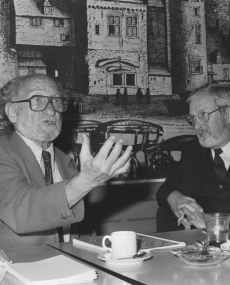
The son of a rabbi, Leslie Rubin was born on 5 August 1909 in District Six, Cape Town, Cape Province (now Western Cape), then a multiracial district of the city. He was educated at Durban High School in Natal (now KwaZulu-Natal), before attending the University of Cape Town (UCT), the University of the Witwatersrand, Transvaal Province (now Gauteng), and the University of South Africa (UNISA) respectively.
A lawyer by profession, Rubin began his legal practice in Durban where he became active in civic and Jewish affairs, the Durban Parliamentary Society, as well as the Society of Christians and Jews. He campaigned against the loss of the African vote in the then Cape Province in 1936.
After joining the South African army as a private in 1940, Rubin was commissioned as an officer in the intelligence corps in North Africa and was later attached to the Royal Air Force (RAF) in Italy. After the war, he settled in Cape Town where he joined the War Veterans’ Torch Commando, an organisation led by fighter pilot Sailor Malan, formed to oppose the Nationalist government’s plan to remove Coloured voters from the common roll.
Together with writer Alan Paton, Rubin attempted to persuade Jan Hendrik Hofmeyr – a leading United Party (UP) parliamentarian – to form a liberal party. However, they were unsuccessful. Undeterred, they went ahead anyway, and on 9 May 1953, Rubin and Paton, along with the likes of Margaret Ballinger, Henry Selby Msimang, Leo Marquard, and Peter Brown, founded the Liberal Party of South Africa (LPSA). The party, formed out of the belief that Jan Smuts’ UP was in disarray following his death in 1950 and that the UP could not bring about liberal progress in South Africa, brought together people of different races in opposition to the apartheid regime. Initially, the LPSA campaigned for a franchise-based vote for Black South Africans, but this later changed to a call for a ‘one man one vote’ system.
Rubin became the chairperson of the Liberal Party in the Cape. In 1954, he was elected to the Senate as what was then called a ‘natives’ representative’ – a position he used to fight every piece of apartheid legislation. Whenever he got up to speak, the Minister of Native Affairs, Dr Hendrik Verwoerd (considered the architect of apartheid), would leave the chamber in protest. On one particular occasion, the entire Nationalist party caucus walked out.
Rubin resigned from the Senate in 1960, when the native representatives’ seats were abolished, while writing the campaigning pamphlet, This is Apartheid. In that same year, Chief Albert Luthuli, a close friend of Rubin’s, was awarded the Nobel Peace Prize and he invited Rubin to accompany him to Sweden to collect it.
In 1960, Rubin went into exile. He first went to Ghana, where he was director of the Centre for African Law at the University of Ghana in Accra, before teaching at various universities, including Queen’s University Belfast in the United Kingdom (UK) and Howard University in Washington DC, United States of America (USA). While in Ghana, Rubin was contacted by John Lang, also a member of the LPSA, who asked him to assist in sourcing funds for the National Committee for Liberation (NCL) – later renamed the African Resistance Movement (ARM) – from the Ghanaian government. Subsequently, the NCL received two payments in 1961, incidentally becoming the first armed resistance group to get finance from Ghana – the African National Congress (ANC) and Pan Africanist Congress (PAC – now known as the Pan Africanist Congress of Azania) only followed later.
In 1968, Rubin and his son, Neville Rubin (an academic lawyer and, like his father, a former anti-apartheid activist), collaborated to produce an enlarged edition of This is Apartheid. This was later expanded again with the support of the United Nations (UN), resulting in Apartheid in Practice in 1972.
Rubin was elected chairperson of the United States Committee of the International Defence and Aid Fund (US-IDAF), where he worked to get funds to South Africa to support political prisoners and their families. Never giving up his fight against the injustices of the apartheid system, he continued denouncing apartheid on public platforms until its demise. His self-imposed exile lasted for thirty-four years, returning home in 1994.
Leslie Rubin died at the age of 92 on 31 March 2002. An outspoken opponent of the apartheid regime, he did not lose his optimism, even during the darkest days of apartheid. He is survived by his son, Neville Rubin.